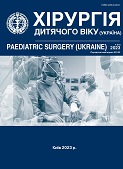Omphalocele - regarding management and treatment tactics
DOI:
https://doi.org/10.15574/PS.2023.81.75Keywords:
omphalocele, treatment methods, clinical cases, childrenAbstract
An omphalocele is an abdominal defect covered by a membranous sac consisting of three layers: peritoneum, jelly of the ventricle and amnion as the outer layer. The vessels of the umbilical cord flow into the top of the pouch, which usually contains the herniated abdominal contents: intestines, liver, spleen, bladder and/or gonads. The pouch covers and protects the herniated organs from harmful external influences.
Purpose - to improve care for patients with omphalocele, improve their life quality by updating treatment standards using the experience of other countries around the world.
A literature review is provided and personal experience is highlighted - 2 clinical cases with a diagnosis of omphalocele. Both underwent operative treatment. All children recovered and were discharged from the clinic.
Depending on the clinical manifestations, the size of the defect and the content of the hernia sac, the term and tactics of treatment differ.
Conclusions. The discussion about the tactics of omphalocele treatment depending on the size is still relevant. Clinical recommendations for the management of omphalocele remain only recommendations, and in each individual case, the decision regarding the terms and methods of treatment remains with the surgeon. It is necessary to remember the possibility of entrapment, which forces the surgeon to perform urgent surgical intervention.
No conflict of interests was declared by the authors.
References
Bielicki IN, Somme S, Frongia G, Holland-Cunz SG, Vuille-Dit-Bille RN. (2021, Feb 23). Abdominal Wall Defects-Current Treatments. Children (Basel). 8(2): 170. https://doi.org/10.3390/children8020170; PMid:33672248 PMCid:PMC7926339
Calzolari E, Volpato S, Bianchi F, Cianciulli D, Tenconi R, Clementi M et al. (1993). Omphalocele and gastroschisis: a collaborative study of five Italian congenital malformation registries. Teratology. 47: 47-55. https://doi.org/10.1002/tera.1420470109; PMid:8475457
Campos BA, Tatsuo ES, Miranda ME. (2009, Jul). Omphalocele: how big does it have to be a giant one? J Pediatr Surg. 44(7): 1474-1475; author reply 1475. https://doi.org/10.1016/j.jpedsurg.2009.02.060; PMid:19573683
EUROCAT. (2023). Prenatal detection rates charts and tables. URL: https://eu-rd-platform.jrc.ec.europa.eu/eurocat/eurocat-data/prenatal-screening-and-diagnosis_en.
Frolov P, Alali J, Klein MD. (2010, Dec). Clinical risk factors for gastroschisis and omphalocele in humans: a review of the literature. Pediatr Surg Int. 26(12): 1135-1148. Epub 2010 Aug 31. https://doi.org/10.1007/s00383-010-2701-7; PMid:20809116
Gray DL, Martin CM, Crane JP. (1989, May). Differential diagnosis of first trimester ventral wall defect. J Ultrasound Med. 8(5): 255-258. https://doi.org/10.7863/jum.1989.8.5.255; PMid:2523977
Hasan S, Mitul AR, Ali A, Ferdous KMN, Huq U. (2018). Omphalocele and Gastroschisis: Comparison of Outcome in A Resource Limited Tertiary Centre. Paediatric Surgery. Ukraine. 2(59): 32-35. https://doi.org/10.15574/PS.2018.59.32
Hershenson MB, Brouillette RT, Klemka L, Raffensperger JD, Poznanski AK, Hunt CE. (1985, Aug). Respiratory insufficiency in newborns with abdominal wall defects. J Pediatr Surg. 20(4): 348-353. https://doi.org/10.1016/S0022-3468(85)80217-7; PMid:2931509
Marshall J, Salemi JL, Tanner JP, Ramakrishnan R, Feldkamp ML, Marengo LK et al. (2015, Aug). Prevalence, Correlates, and Outcomes of Omphalocele in the United States, 1995-2005. Obstet Gynecol. 126(2): 284-293. https://doi.org/10.1097/AOG.0000000000000920; PMid:26241416
Rusak PS, Konoplitskyi VS, Fofanov OD. (2020). Vady rozvytku cherevnoi stinky u ditei. Monohrafiia. Zhytomyr: «Polissia»: 148.
Shi X, Tang H, Lu J, Ding H, Wu J. (2021). Prenatal genetic diagnosis of omphalocele by karyotyping, chromosomal microarray analysis and exome sequencing. Annals of medicine. 53; 1: 1285-1291. https://doi.org/10.1080/07853890.2021.1962966; PMid:34374610 PMCid:PMC8366676
Sliepov O, Migur M, Soroka V, Ponomarenko O. (2018). Surgical management of simple gastroschisis. Paediatric Surgery. Ukraine. 2(59): 25-31. https://doi.org/10.15574/PS.2018.59.25
Sliepov OK, Hrasiukova NI, Veselskyi VL ta in. (2014). Chastota zatrymky vnutrishnoutrobnoho rozvytku ploda ta yii vplyv na perebih i prohnoz pry hastroshyzysi. Perynatolohiia ta pediatriia. 2: 58.
Sliepov OK, Migur MYu, Gordienko IYu et al. (2017). A case of small bowel obstruction of a rare etiology in a newborn with gastroschisis. Paediatric Surgery. Ukraine. 2(55): 27-31. https://doi.org/10.15574/PS.2017.55.27
Stallings EB, Isenburg JL, Short TD, Heinke D, Kirby RS, Romitti PA et al. (2019, Nov 1). Population-based birth defects data in the United States, 2012-2016: A focus on abdominal wall defects. Birth Defects Res. 111(18): 1436-1447. Epub 2019 Oct 23. https://doi.org/10.1002/bdr2.1607; PMid:31642616 PMCid:PMC6886260
Waller DK, Shaw GM, Rasmussen SA, Hobbs CA, Canfield MA, Siega-Riz AM et al. (2007). Prepregnancy obesity as a risk of structural birth defects. Arch Pediatr Adolesc Med. 161: 745-750. https://doi.org/10.1001/archpedi.161.8.745; PMid:17679655
Downloads
Published
Issue
Section
License
Copyright (c) 2023 Paediatric Surgery (Ukraine)

This work is licensed under a Creative Commons Attribution-NonCommercial 4.0 International License.
The policy of the Journal “PAEDIATRIC SURGERY. UKRAINE” is compatible with the vast majority of funders' of open access and self-archiving policies. The journal provides immediate open access route being convinced that everyone – not only scientists - can benefit from research results, and publishes articles exclusively under open access distribution, with a Creative Commons Attribution-Noncommercial 4.0 international license(СС BY-NC).
Authors transfer the copyright to the Journal “PAEDIATRIC SURGERY.UKRAINE” when the manuscript is accepted for publication. Authors declare that this manuscript has not been published nor is under simultaneous consideration for publication elsewhere. After publication, the articles become freely available on-line to the public.
Readers have the right to use, distribute, and reproduce articles in any medium, provided the articles and the journal are properly cited.
The use of published materials for commercial purposes is strongly prohibited.

